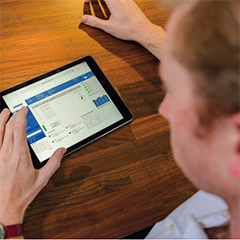When it was first introduced to the maritime market, Damen’s Fast Crew Supplier (FCS) 2710 – the successor to the FCS 2610 – hit the headlines for many reasons. Stepless and safe crew transfers, increased passenger capacity and an optimised hull are all pieces of the puzzle that illustrate the evolving design. All in all, the new FCS 2710 packs a lot of vessel into its 24-metre load line. Despite all the media attention, there is one particular development on the FCS 2710 that deserves to be put into the spotlight: its on board vessel monitoring system.
The launching customer of the first FCS 2710 was UK-based offshore crew transfer service provider High Speed Transfers, a relatively young company with a clear focus on the European offshore wind sector. The company deploys this first vessel, called HST Hudson, to transport up to 26 personnel to their offshore workplace with a combination of high speed and comfort. With regard to the subject of this article, though, the most notable feature of the HST Hudson is that it is the first new build vessel from Damen’s high-speed craft portfolio to be equipped with vessel monitoring equipment.
Impact loads
This raises the question: what were the motivations behind installing a vessel monitoring system on board a crew transfer vessel? ‘For this client, one of the most important aspects was to measure the impact of the boat landing on the turbine platform,’ replies Thijs Muskens, design & proposal engineer at Damen. ‘These turbines are designed to cope with a certain load and it is the captain’s responsibility, and therefore our responsibility, to make the approach as smooth as possible and not exceed the impact threshold limit. Offshore wind majors are becoming increasingly data-driven and desire fact-based proof of impact loads for the vessels operating in a wind farm. This proof can be generated by the connected ship system.’
In addition to the actual landing on the turbine, comfortable transport from shore to the wind farm is another part of the process. To this end, another reason to gather data is to improve the comfort of this journey. ‘This is an important feature in our entire range of high-speed craft,’ he continues. ‘We want vessels like the FCS 2710 to be as comfortable as possible. In general, the technical personnel on board do not have that much experience at sea and, as a result, are more prone to seasickness than experienced crews. We want to postpone this for as long as possible and gaining insight into the perceived comfort can help us do so.’



























